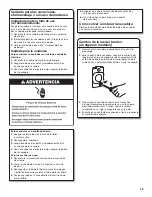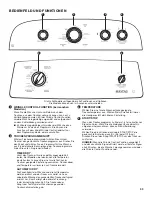
39
PER LA VOSTRA SICUREZZA
1. NON USARE O RIPORRE BENZINA O MATERIALI INFIAMMABILI NELL’APPARECCHIO O NELLE SUE
VICINANZE.
2. NON USARE PRODOTTI SPRAY IN PROSSIMITÀ DELL’APPARECCHIO MENTRE È UN FUNZIONE.
3. NON MODIFICARE L’APPARECCHIO.
n
Non utilizzare l’asciugatrice se sono state usate sostanze
chimiche industriali per la pulizia.
n
Rimuovere tutti gli oggetti dalle tasche, come accendini
e fiammiferi, prima di inserire i capi nell’asciugatrice.
n
Prima di dismettere o smaltire l’asciugatrice, rimuovere
le porte del vano di asciugatura.
n
Non inserire la mano nell’asciugatrice se il tamburo è in
movimento. È predisposto un interruttore di sicurezza per
la porta.
n
Non installare o riporre l’asciugatrice in luoghi esposti agli
agenti atmosferici.
n
Non manomettere i comandi.
n
Non continuare a usare l’apparecchio se sembra difettoso.
n
Non riparare o sostituire parti dell’asciugatrice o tentare
alcuna manutenzione a meno che non sia chiaramente
indicato nella Guida all’uso e alla manutenzione. Le riparazioni
e la manutenzione devono essere eseguite esclusivamente
da personale di assistenza competente.
n
Non utilizzare ammorbidenti per tessuti per eliminare
l’elettricità statica a meno che non siano consigliati dal
fabbricante dell’ammorbidente o del prodotto. Seguire
le istruzioni del fabbricante.
n
Pulire il filtro pelucchi prima o dopo ogni carico. Non
mettere in funzione l’asciugatrice senza il filtro pelucchi.
n
Mantenere pulita l’area intorno allo sfiato e alla presa
dell'aria, nonché le aree circostanti, eliminando pelucchi,
polvere e sporcizia.
n
L’interno dell’asciugatrice e il tubo di sfiato devono esser
puliti periodicamente da personale di assistenza qualificato.
n
Vedere le istruzioni per la messa a terra.
n
Non asciugare in asciugatrice capi che non siano stati lavati.
n
La parte finale di un ciclo di asciugatura non utilizza calore
(ciclo di raffreddamento), per assicurare che i capi siano
lasciati a una temperatura che non li danneggi.
n
Capi in gommapiuma (schiuma di lattice) cuffie per doccia,
tessuti impermeabili, articoli con fodera gommata e indumenti
o cuscini con imbottitura di gommapiuma devono essere
asciugati appesi.
n
Se il cavo di alimentazione è danneggiato, deve essere
sostituito dal produttore, da personale di assistenza o
da una persona con qualifica analoga per evitare rischi.
AVVERTENZA:
non arrestare mai l’asciugatrice prima
del termine del ciclo di asciugatura, salvo se si estraggono
velocemente tutti i capi e li si stende per disperdere il calore.
ISTRUZIONI IMPORTANTI PER LA SICUREZZA
AVVERTENZA:
per ridurre il rischio di incendio, scossa elettrica o lesioni alle persone durante l’uso dell’asciugatrice,
prendere le dovute precauzioni di base, tra cui:
CONSERVARE QUESTE ISTRUZIONI
n
Leggere tutte le istruzioni prima di usare l’asciugatrice.
n
Mantenere una distanza minima di 100 mm (4 poll.) tra il lato
posteriore dell’asciugatrice e la parete.
n
La messa in funzione dell’apparecchio può influenzare la
messa in funzione di altri tipi di apparecchio che attingono
l’aria per la combustione sicura dallo stesso locale. Deve
essere presente un’aerazione adeguata che permetta la
sostituzione dell’aria consumata ed eviti che i gas derivanti
da altri apparecchi che bruciano altri carburanti, incluse
fiamme libere, rifluiscano nell’ambiente durante l’utilizzo
dell’asciugatrice a tamburo. In caso di dubbio consultare i
produttori degli apparecchi.
n
Non ostruire la presa d’aria dell’asciugatrice (vedere
le Istruzioni di installazione per gli spazi liberi minimi).
n
Non inserire nell’asciugatrice capi sporchi di olio da cucina.
I capi sporchi di olio possono prendere fuoco in modo
spontaneo, specialmente se esposti a sorgenti di calore, come
nell’asciugatrice. Questi capi si riscaldano a causa di una
reazione di ossidazione nell’olio. L’ossidazione genera calore.
Se il calore non riesce a disperdersi i capi possono riscaldarsi
al punto di incendiarsi. Quando i capi contaminati con olio
sono ammucchiati, impilati o riposti possono impedire la
dispersione del calore e creare un rischio di incendio.
n
Se è inevitabile asciugare in asciugatrice capi sporcati con
sostanze come olio da cucina, acetone, alcol, benzina,
kerosene, smacchiatori, acquaragia, cere e deceranti o che
sono stati contaminati con prodotti per capelli, è necessario
lavarli in acqua molto calda con una quantità di detergente
aggiuntiva prima di essere asciugati in asciugatrice. Questi
capi possono sprigionare vapori che potrebbero incendiarsi
o esplodere. Il lavaggio sopra descritto riduce ma non
elimina il rischio.
n
Questo apparecchio non è destinato all’uso da parte di
persone, inclusi bambini di età inferiore a 8 anni, con ridotte
capacità fisiche, sensoriali o mentali o con esperienza e
conoscenze inadeguate, a meno che non siano sorvegliati o
abbiano ricevuto istruzioni relative all’uso dell’apparecchio da
parte delle persone responsabili della loro sicurezza.
n
La pulizia e la manutenzione ordinaria non devono essere
effettuate da bambini senza la supervisione di un adulto.
n
Sorvegliare i bambini affinché non giochino con
l’apparecchio.
n
Tenere i bambini di età inferiore a 3 anni lontano
dall’apparecchio a meno che non siano direttamente
sorvegliati.
4
IMPORTANT SAFETY INSTRUCTIONS
precautions, including the following:
WARNING:
Read all instructions before using the dryer.
Keep a minimum clearance of 100 mm (4 in.) between the
rear of the dryer and any wall.
The operation of this appliance may affect the operation of
other types of appliances which take their air supply for safe
combustion from the same room. There has to be adequate
ventilation to replace exhausted air and thus avoid the
back-flow of gases into the room from appliances burning
other fuels, including open fires, when operating the tumble
dryer. If in doubt, consult the appliance manufacturers.
Do not obstruct the air supply to the dryer (see Installation
Instructions for minimum clearances).
Do not place items exposed to cooking oils in your dryer.
Oil-affected items can ignite spontaneously, especially when
exposed to heat sources such as in a tumble dryer. The
items become warm causing an oxidation reaction in the oil.
Oxidation creates heat. If the heat cannot escape, the items
can become hot enough to catch fire. Piling, stacking or
storing oil-affected items can prevent heat from escaping
and so create a fire hazard.
If it is unavoidable to dry in the dryer items that have been
soiled with substances such as cooking oil, acetone, alcohol,
petrol, kerosene, spot removers, turpentine, waxes and wax
removers, or that have been contaminated by hair care
products, should be washed in hot water with an extra
amount of detergent before being dried in the dryer. These
items may give off vapours that could ignite or explode. Such
washing will reduce, but not eliminate, the hazard.
This appliance is not intended for use by persons (including
children) with reduced physical, sensory or mental
capabilities, or lack of experience and knowledge, unless
they have been given supervision or instructions concerning
use of the appliance by persons responsible for their safety.
Children should be supervised to ensure that they do not
play with the appliance.
The dryer should not be used if industrial chemicals have
been used for cleaning.
Before the dryer is removed from service or discarded,
remove the doors to the drying compartment.
Do not reach into the dryer if the drum is moving. A door
switch is fitted for your safety.
Do not install or store the dryer where it will be exposed
to the weather.
Do not tamper with controls.
Do not continue to use this appliance if it appears to be
faulty.
Do not repair or replace any part of the dryer or attempt
any maintenance unless specifically recommended in this
Use and Care Guide. Repairs and servicing should only
be carried out by competent service personnel.
Do not use fabric softeners or products to eliminate static
unless recommended by the manufacturer of the fabric
softener or product. Follow their instructions.
Clean dryer lint screen before or after each load. Do not
operate dryer without lint screen in place.
Keep area around the exhaust and inlet openings and
adjacent surrounding areas free from the accumulation of
lint, dust, and dirt.
The interior of the dryer and exhaust vent should be
cleaned periodically by qualified service personnel.
See Installation Instructions for earthing instructions.
Do not dry unwashed items in this dryer.
Items such as foam rubber (latex foam), shower caps,
waterproof textiles, rubber backed articles and clothes or
pillows fitted with foam rubber pads must only be dried
on a clothesline.
SAVE THESE INSTRUCTIONS
WARNING:
Never stop a tumble dryer cycle before the
end of the drying cycle unless all items are quickly removed
and spread out so that the heat is dissipated.
To reduce the risk of fire, electric shock, or injury to persons when using the dryer, follow basic
The final part of a tumble dryer cycle occurs without heat
(cool down cycle) to ensure that the items are left at a
temperature that ensures the items will not be damaged.
If the supply cord is damaged, it must be replaced by the
manufacturer or its service agent or a similarly qualified
person in order to avoid a hazard.
















































